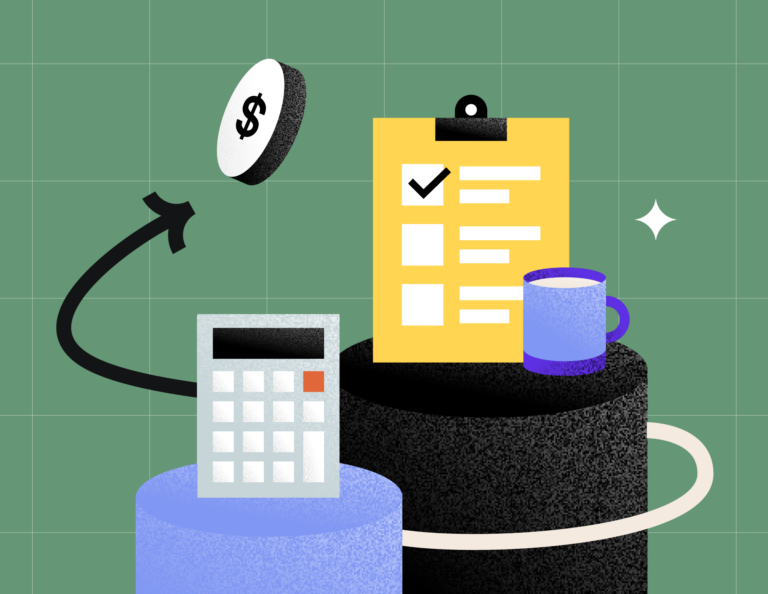Ready to level up your business? Learn how to raise prices this year and do it successfully so your new and current clients understand your increased value.

This year, it may be time to reconsider your pricing. Determining both when and how to raise prices as a business owner can be a challenging process to navigate. You may already have a pricing strategy in place, but are unsure how to grow beyond that. And you’re not alone—many business owners find themselves caught in a cycle of self-doubt and uncertainty when it comes to raising their prices.
If you’re considering changing your business rates, read on to learn helpful ways to prepare and strategies for how to raise prices this year.
Jump to:
- Signs you should raise your prices this year
- How to raise your prices in 5 steps
- Tips for raising your prices
Signs you should raise your prices this year
There are several reasons why you should adjust your pricing periodically. For one, rising inflation rates, economic changes, and shifts in the industry can have an impact on your profitability. When there are cost increases, you need to ensure your cash flow stays green.
You might also notice a growing demand for your services, heightened expertise, or an improved client experience—factors that all signal a need for price hikes. While maintaining your current prices might feel like the easiest or most comfortable option, changing your pricing structure or increasing your prices is essential to business growth.
You notice an increase in expenses
When tracking your expenses, do you notice certain costs going up compared to the previous year? Whether it’s inflation or the need for more equipment and materials, higher expenses are a signal that it’s time to raise prices. Ultimately, you always want to maintain a positive cash flow, so ensuring you have a greater profit than loss is key. There are different strategies in play to do so, but raising your prices is one of them.
You’ve gained more expertise in the past year
Whether you’ve taken a course, received a new certification, or gained additional client experience, your growth in industry expertise may be a sign to raise your prices. Ask yourself, “What added value can clients gain from this growth?” and “How can this knowledge help me better serve my audience?” As you grow in your industry and expertise, your prices should continuously grow with you
You have limited capacity for new clients
As a busy independent, time is money. And if your time is constrained—with current client work, new client demand, or your lifestyle—your capacity to take on new work is in short supply. Raising your prices will allow you to take on fewer projects, free up additional time to pursue other tasks, and begin attracting higher-paying clients.
You’ve upgraded your client experience
As your business has grown, perhaps your client experience has improved. Each touchpoint the client has with your brand adds value to the service overall, so don’t be afraid to charge more for a heightened client experience. People will typically be willing to pay more for a higher quality service or product.
You’ve set a goal to grow your business
Are you planning to hire additional team members this year? Will you need to invest in new tools, resources, and systems to grow your business in 2025? If you plan to invest more money into your business this year, the prices you charge clients may need to increase with the investment.
How to raise prices in 5 steps
If you’re ready to raise prices this year, start preparing now. Give yourself enough time to follow the necessary steps to implement and communicate changes to your pricing, allowing you to confidently enter the new year with new rates. Be prepared and learn how to raise prices by following these five steps.
1. Reflect on your pricing strategy, industry, and ideal clients
Is your current pricing strategy working for you? How does your pricing compare to others in the industry? Are you attracting your ideal clients? Now is a great opportunity to reflect on your business’s finances, the competitive landscape, and your business goals. Consider whether or not you should reevaluate your approach to pricing.
Perhaps if you’re at your maximum working capacity but aren’t hitting the income goals you aim to achieve, you could start targeting higher-paying clients or create a scarcity of your products and services to boost demand. If you notice your offers are priced way below market compared to others in the industry, you may want to reconsider your pricing strategy and how you charge customers.
Reflect on where you’re at now compared to where you want to be a year from now. If you find that your current pricing strategy isn’t serving you and your business goals, it may be time to change your approach to pricing.
2. Define your value
Your expertise is valuable and defining what that added value is can help clients feel confident in what they can gain from working with you. What pain points are you solving for clients? What sets you apart from others in the industry? Do you have data or testimonials that showcase your best work?
Appeal to existing clients and attract new ones by highlighting your value. Showcase your previous work and business success in a case study, website portfolio, pricing guide, or on social media. Increase the perceived value of your service by providing success metrics, work samples, and client testimonials.
Defining your value will help promote your offerings to clients, while simultaneously providing you with proof points to feel confident in your expertise and ability to help solve customers’ problems.
3. Project your goals and availability
Do you dream of working fewer hours? How about bringing in bigger paychecks each month? Perhaps a combination of the two? As you look ahead to the rest of the year, you’ll want to equate your financial goals with the number of working hours you expect or want to put forth each month (plus the number of months you intend to work next year). These will help to determine the number of new projects you’ll need to take on each month to achieve your goals with updated pricing in place.
When equating your availability and goals, be sure to track the amount of time it actually takes to complete a given task or project so that you can better plan for the future. That means adding up all the time spent on the communications, ideation, execution, and delivery of your services or products. Always overestimate how long work will take and consider using a time tracker tool to help manage your time.
Most importantly, account for your physical, mental, and emotional capacity for work. Building a business you love that serves you means identifying your capacity and how you want to work.
4. Notify your current clients
When you raise your prices, you must notify your existing clients and customer base well in advance. Provide them with some context for the price rise, but keep it short and sweet. Open the floor to questions, communicate your timeline for the price raises clearly, and send follow-up communications to avoid confusion.
By telling customers about price increases in advance, you can ensure customer loyalty. Otherwise, your clients can feel like you’re unreasonably springing higher costs on them.
When informing your customers, ensure that your tone remains informative rather than asking for permission. Provide details about why prices are increasing so your clients can understand the value they’re getting.
Pro tip
Make sure you pay attention to your current contracts. If your clients are on a contract at a certain price, you can’t increase their pricing until the contract ends.
Need help? Copy this price increase template for an easy way to notify your customers:
Copy/paste template:
Email notifying clients of price raise
Subject: Important! Increase in prices coming [Month] 2025
Hi [Name],
My team and I at [Company Name] have been focused on improving our client experience for the past year, and hope you’ve noticed! Just in the past [time period] alone, we’ve:
- List a few bullets here of value-adds
- They can be general or specific to each client
- No need to list everything, just the highlights
Due to these new offerings and increased costs, we’ll be raising our prices starting [Date or Month]. [Drop in your price change here, whether it’s increasing your hourly rate or your package pricing].
What does that mean for you?
Since you’re on a contract already, your pricing will not change. However, if you choose to renew your contract with us in [Date], it will be at the updated according to the forthcoming price increases.
Thank you as always for being a valued customer– we aim to continue improving to meet your needs.
Sincerely,
[Your Name]
5. Update your pricing across all touchpoints
Lastly, ensure you remember to update your pricing across all brand touchpoints. Include your new pricing on your website, pricing guides, and brochure templates, sales platforms, and profiles to reflect your updated offerings. Don’t forget to highlight your value when you promote and raise your prices so that prospective new clients feel eager to work with you.
Tips for raising your prices this year
Consider promoting your updated rates with these effective pricing strategies.
End prices in 9
Ending prices in ‘9’ or ‘99’ is a scientifically proven tactic often used by marketers to boost sales. People tend to focus on the lower digit on the left and round down, making the price seem more affordable.
Offer pricing tiers
Appeal to clients of different price points by showcasing your offers in three to four package levels. Generally, the middle package will offer the most appealing price while posing the best value for clients, and the other packages will be priced at lower and higher ticket prices.
Instill trust
Nothing sells customers on a service or product’s value quite like hearing about other people’s experiences with them. Place client testimonials and reviews in close proximity to wherever your updated pricing appears. If you don’t already have testimonials for your business, reach out to previous and current clients to ask them to provide some.
Demonstrate your value with a clientflow platform
HoneyBook’s clientflow management platform helps independent business owners create dynamic, interactive pricing guides that they can send to clients online. Beyond standard file templates, these files go a step further to connect your clientflow. If you want to create a more streamlined process, you can create a HoneyBook pricing guide that allows clients to select services and pay online in just one step, instead of going back and forth with you over email.

Capture leads, sell services, manage projects, and nurture client relationships from one platform. All that and more with HoneyBook.



